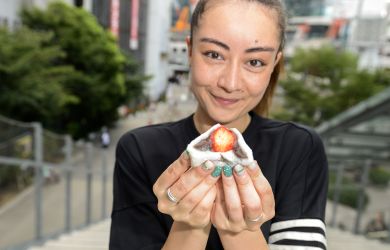
April 13, 2006
Flower Power
Spring in Tokyo is the start of a vibrant cycle of new colors that abound even in this concrete jungle
By Metropolis
Originally published on metropolis.co.jp on April 2006

A chrysanthemum at an October festival at Yushima Tenjin
Photos by Stephen Mansfield

Spring magnolias in full bloom at a temple in Ikegami
New leaves of an almost transparent beauty are a sign of spring, as are sweet daphne, yellow kerria, violet, rape plants, early varieties of April iris, and cherry blossoms. The cherry, more than any other flower, has come to symbolize that very Japanese feeling known as mono no aware: an exquisite but melancholic awareness of the impermanence of life. The cherry that infatuated old Japan was the yama-zakura, found growing on the craggy slopes of relatively soil-poor hills. Though yama-zakura are still much appreciated, these days you are more likely to see the ubiquitous somei-yoshino, a blossom cultivated in Tokyo in the 19th century.
You may also come across clusters of wild shunran (spring orchids), wild rose, chigoyuri (fairy bells) and daffodils. The delicate flowers of the Chinese milk vetch, a species introduced to Japan from mainland Asia during the Muromachi Period (1333-1568), is another reminder of spring.
As plum, cherry and peach blossoms vanish, look out for flowering bushes. The most extensively planted and used in Tokyo is, arguably, the azalea, a flower that comes in red, purple and white. The effect of great, bunched groupings of flowers against the new spring green of a bush can be very impressive, especially when used as street borders or piled up in curving banks and hillocks. There are many azalea festivals in the Tokyo region, the best known perhaps held at the Nezu Shrine, where there are hundreds of bushes. The festival runs from April 10 through May 5. The mid to latter days are usually the best.

A lotus in Ueno’s Shinobazu Pond
The first inklings of the Tokyo summer are felt with the blossoming of the wisteria, rainy season irises and hydrangea; the vibrant blue and purple Japanese bellflower and the fragrant gardenia follow. Other flowers encountered in this season are peonies, China aster, clematis, the yellow linden, Japanese meadowsweet, hollyhock, fragrant lilies of many different varieties, the vivid pink of the crepe myrtle, great trumpet flowers, morning glory and the water lily.
The iris is closely associated with early summer rainy season. Although quite well-known to the Japanese, few foreigners are aware of the existence of the Horikiri Shobuen, where iris cultivation began in the swampy, riverside land of east Tokyo during the 1660s. The formal garden beside the Sumida River, a ten-minute walk from Horikiri Shobuen station in Katsushika Ward, dates from the 19th century.
The lotus, though, is the perfect summer flower, the prince of this sweltering season. Pleasing to the eye, with roots and pods that are edible, it is also a symbol of esoteric Buddhism. Identified with the deity Kannon, the lotus bud came to symbolize salvation for the faithful. In the lotus pond of the Pure Land, the broad, pulpy leaves serve as seats for Amitabha Buddha and other divinities. Fresh lotus flowers were once placed on family altars during the summer O-bon festival, welcoming the spirits of the ancestors back to Earth, a time of year when it is still possible to see Buddha statues adorned with golden lotuses.
Dawn is the best time to view the flowers, when they have just opened and when the intense heat of late morning is still mild and formless. Akira Kurosawa, in his book Something Like An Autobiography, wrote that he’d heard “when lotus flowers bloom they make a wonderful, clear bursting sound,” and wanted to see for himself. “One morning I got up very early and trekked to Shinobazu Pond in Ueno to listen to the lotuses open,” he wrote. “And in the dim mists of morning I heard that sound.” Follow in Kurosawa’s footsteps in the early morning and you, too, may have that pleasure.

Azaleas brighten up a back street
The brilliant reds of the maple signal the onset of autumn in both mountain and city gardens. Sweet osmanthus, also known as fragrant olive, red spider lilies, the sasanqua camellia and the chrysanthemum are other elements of this season. Hagi (bush clover) is one of the classical seven flowers of autumn. Blooming in September, its small flowers clustered in racemes have a special appeal. Hagi is often included in formal gardens to give them a rustic, natural touch—a good example being the clover trellis at the Edo-period Hyakka-en garden in Tokyo’s Higashi-Mukojima district. The other flowers that make up the classic seven for autumn are the kikyo (balloon flower), fujibakama (Japanese boneset), ominaeshi (patrina), nadeshiko (fringed pink flower), kudzu, and the susuki (miscanthus), all represented at the Hyakka-en.
In many respects, the chrysanthemum is Japan’s premier flower, at least in autumn, when this highly esteemed bloom, which symbolizes a quieter, more mature and contemplative season, comes into its own. Early November is, perhaps, the best month to appreciate this flower. At this time, gardens, parks and temple grounds become venues for Kiku Matsuri (Chrysanthemum Festivals). Among the tables of chrysanthemum bonsai, representations of miniature temples, traditional toys and boats, are kiku-ningyo, life-sized dolls representing court ladies and historic figures attired in kimono, all carefully fashioned out of the blossoms.
One of the finest places to view chrysanthemums is at Tokyo’s old Imperial park, Shinjuku Gyoen, where stalls and bamboo pavilions decorated with red and white cloth and purple banners create a brocade effect from a distance, with display tiers and vertical beds of flowers trained over an almost invisible frame of supportive wire. Chrysanthemum cascades, planted months in advance and rising to heights of almost 2m, are cultivated by attaching the new stems of potted plants to a wire arrangement.
As the Chinese sages wrapped themselves in their quilted robes with the advent of winter, the yang forces, still strong in late autumn, would begin to fade, making way for the softer, more pliable yin forces. Just as the scholars believed that winter was a time for quiet pleasures, contemplation and study, this is the most introspective season for Japanese flora, but winter gardens are rarely completely bereft of color. There are evergreens, broad-leaf plants, and even the occasional bloom. This is the season for the glossy red berries of the senryo, a shrub whose name means “a thousand gold pieces.” Senryo are often planted just inside the garden gate, to welcome New Year’s guests. (Red has always been considered a lucky color in Asia.) Another hardy evergreen shrub, jinchoge (sweet daphne), releases an enchanting fragrance into the air in late February. The scent that perhaps best embodies winter is the witch hazel, which, on a crisp morning, can act as a stimulant tingeing the air.
At the end of this season, plum blossoms, known to the Japanese as hatsu-hana (the first flowers of the year), make a welcome appearance. The plum tree represents the transition from winter to spring, a quality much celebrated in woodblock prints, hanging scrolls and screen paintings. The transformation is extraordinary: “From one hoary blackened branch,” as landscape gardener Mark P. Keane has observed, “a vivid symbol of agedness, springs a multitude of delicate blossoms, the picture of youth.” The Ikegami Plum Garden in Ota Ward is one of the finest places to view the blossoms in Tokyo. Soon to follow, bringing another riotous year of color, are the cherry blossoms.
Rising tourism to England in the ’80s, a number of imported British gardening programs, and the proliferation of rose gardens in almost every Japanese suburb these days have, collectively, triggered a boom in creating “English gardens.” Garden suppliers stocking traditional Japanese materials have suffered as a result of this interest, doing better, it seems, selling standard English flowers such as poinsettias, lupines and dahlias, and a range of garden ornaments and accessories—plastic gnomes, frogs and fairies, plaster wheelbarrows and rose trellises—that would not look out of place in the Home Counties. Here, the effect can be rather mixed, not unlike the efforts to construct Japanese gardens in Britain. City nurseries are well-stocked these days with seeds, saplings, pots, planters and all the tools you could ever dream of for a spot of weekend English-style gardening.
You don’t need much room, either, to cultivate a green or flowering patch, even in space-starved Tokyo. Balconies, sunny window areas, the borrowed fringes of apartments will all serve nicely. Take a walk around downtown districts of Tokyo like Sendagi, Mukojima and Negishi for clues on how to make the most of restricted space. Here you will find small plots where residents have requisitioned the narrow strips between their frontages and the street to place their pots, planters and tiered display tables.
Garden centers out in the suburbs are still able to offer more obvious Japanese plantings, as well as stone like water lavers, bamboo dippers, millstones, stelae and stone lanterns strongly associated with the Japanese garden. The art of bonsai, bonseki and suiseki continue to have their followers, and one or two pieces will fit in with almost any small garden arrangement you make, whether Japanese or Western.
For a more Japanese planting touch to your garden, balcony or sunny shelf, look out for sagi-so (egret flower), misohagi (purple loosestrife), fuuro-so (cranesbill), tesen (clematis), and kikyo (Chinese bellflower), which can all be cultivated from seeds in the spring or bought in small pots later in the season. Water plants like hasu (lotus) can also be bought in late spring, but remember that you’ll need to change the water regularly and that water plants attract swarms of mosquitoes. This is a good time to start looking for chrysanthemum seeds. The flower will not reach maturity until October at the earliest, but you can enjoy its growth over the summer.
Although pots will have to be securely fastened, sunny, south-facing balconies are good spots for creating mini-arboretums of miniature pine, podocarp, dwarf maple and juniper. Cycads, known in Japan as sotetsu, add an exotic southern mood to any display. The hardy cycad, a plant that gained much popularity among Japanese garden designers during the Edo Period, is one of the world’s oldest living plant forms, and consequently very hardy too, able to survive quite well even in remote northern areas like Tohoku.
Finally, look out for flower and plant festivals over the late spring and summer. The morning glory fair at Iriya Kishibojin in early July is a lively event of this kind.







